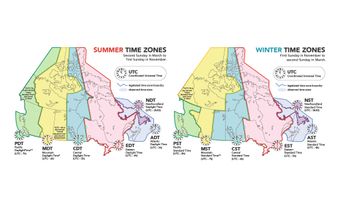Calendar
In Canada the Gregorian calendar is in use under the terms of the 1750 British Act for Regulating the Commencement of the Year, and for Correcting the Calendar Now in Use, which switched the official English calendar from the Julian to the Gregorian form in 1752. The Act declared that the year 1752 would begin on Jan 1 (rather than on March 25, as had been the case in England since the 1300s) following Dec 31, 1751 and that the day following Sept 2, 1752, was to be known as Sept 14, 1752. England, and thereby all the Dominions, had taken the year 1700 to be a leap year; ultimately the year the Gregorian calendar was adopted was a leap year under both calendars. The difference between the Julian and Gregorian calendars amounted to 84 days in 1751 and 11 days in 1752. Thus the shortest years in Canada were 1751, which had only 281 days; and 1752, which had 354 days. In NEW FRANCE prior to this, the Gregorian calendar seems to have been used generally following the edict of Henry III in 1582. Neither the 1582 nor the 1752 change to the Gregorian calendar interrupted the sequence of the days of the week.
First Day of Spring
The Julian calendar and Gregorian calendars both try to approximate the tropical year of 365.2422 days, keeping the dates of the seasons fixed, with the first day of Spring, determined by astronomical observation, remaining near March 21. The scientific justification for the Gregorian calendar, keeping the date of Spring fixed to less than a day in 2000 years, was initially enunciated by the astronomer Clavius, a contemporary of Pope Gregory XIII, after whom the Gregorian calendar is named. Effects unknown in Clavius's time, such as the shortening of the year and the lengthening of the day by tidal friction, and the random variation in the length of the day, will necessitate further calendar reform in the third millennium if the dates of the seasons are to remain fixed.
Leap Year
The Gregorian calendar omits the leap year (so-called in English because a calendar date would leap forward in the week by 2 days for a leap year, instead of just 1 day for a normal year) in any year divisible by 100 unless it is also divisible by 400. Thus the year 2000 is a leap year, but the years 1800, 1900 and 2100 are not. A country switching from the Julian calendar, which uses a different calculation, to the Gregorian calendar had to drop 10 days if the change were done in the 1500s or 1600s, or 11 days in the 1700s, or 12 days in the 1800s or 13 days in the 1900s or 2000s. One exception to this rule was when Alaska changed from Russian to American administration in 1867, and the calendar changed by only 11 days since Alaska also changed sides of the International Date Line (IDL).
In part because of the world-wide acceptance of the Gregorian calendar, the notations AD (Anno Domini) and BC (Before Christ) have started giving way to the notation CE (Common Era, or Christian Era) and BCE (Before Common Era). The year before 1 CE (or AD) is 1 BCE (or BC). There is no year 0 in the Gregorian calendar. Astronomers sometimes use negative years to simplify their time interval calculations, eg, 2 BCE corresponding to -1, 1 BCE to their 0. The absence of a year 0 in the Gregorian calendar also means that the 20th century of the common era ended on Dec 31, 2000, and that the 21st century began on Jan 1, 2001.
Easter
In Canada the legal date for Easter is still determined on the basis of rather involved tables, unlike most other legal holidays. The 1750 British Act also defines the tabular method to be used, eg, the first Sunday after the first "ecclesiastical" full moon that occurs on or after March 21. This full moon is determined by tables of the lunar cycle, rather than by direct observation of the real moon. On several occasions, agreement has seemed near among the world's churches to celebrate Easter on the second weekend of April. Presumably Canadian lawmakers would follow suit if an agreement is finalized.

 Share on Facebook
Share on Facebook Share on X
Share on X Share by Email
Share by Email Share on Google Classroom
Share on Google Classroom


